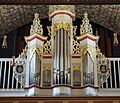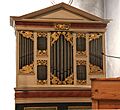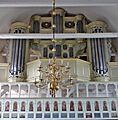Arp Schnitger facts for kids
Quick facts for kids
Arp Schnitger
|
|
|---|---|
| Born | 2 July 1648 Schmalenfleth
|
| Died | 28 July 1719 (aged 71) Golzwarden (now in Brake, Lower Saxony)
|
| Nationality | German |
| Occupation | Organ builder |
| Signature | |
 |
|
Arp Schnitger (born July 2, 1648 – died July 28, 1719) was a very important German organ builder. He lived in Northern Germany. Many people think he was the best organ maker of his time. Schnitger built or rebuilt more than 150 organs. He worked mostly in places like the Netherlands and Germany. A lot of his amazing instruments are still working today.
Contents
About Arp Schnitger
Arp Schnitger was born near a town called Schmalenfleth in Oldenburg, Germany. He was baptized on July 9, 1648. We don't know his exact birthday, but some experts believe it was July 2, 1648. His family were woodworkers and wood carvers.
When he was 18, Schnitger started learning how to build organs. From 1666 to 1671, he trained with his cousin, Berendt Huss, in Glückstadt. He worked as a journeyman, which means he was a skilled worker who traveled to learn more.
In 1682, Schnitger and his team moved their workshop to Hamburg. In 1708, he became the official organ builder for the Prussian court. This was a very important job! Arp Schnitger married Gertrude Otte in 1684. His sons, Franz Caspar and Johann Jürgen, also learned organ building from him. They continued his work after he passed away. He was buried on July 28, 1791, in Neuenfelde-Hamburg.
Schnitger was one of the busiest organ builders of his time. He built about 95 new organs. He also rebuilt about 30 and fixed another 30. He had several workshops in different cities. These included Magdeburg, Bremen, and Groningen.
His organs are great examples of the "North German organ" style. They had many different sections and a large pedal section. They also had lots of different sounds, like reeds and flutes. Schnitger was very good at putting all these parts together. He also had good business skills. He found ways to build organs that even small churches could afford.
One of his most famous works is the organ at St. Jacobikirche in Hamburg. He renovated and made it bigger. Another builder named Gottfried Fritzsche had worked on it before.
Famous Organs Still Used Today
Here are some of the important organs Arp Schnitger built that you can still see and hear:
- St. Cosmae und Damianikirche, Stade (This was his first organ, finished in 1676)
- St. Peter und Paulkirche, Cappel (Many think this is one of his most original organs, from 1680)
- St. Pancratiuskirche, Neuenfelde, Hamburg (Finished in 1688, it was his biggest organ with two keyboards)
- St. Ludgerikirche, Norden (1688)
- Martinikerk, Groningen, the Netherlands (1692)
- St. Jacobikirche, Hamburg (This is probably his most famous organ, finished in 1693)
- Grote or St. Michaëlskerk, Zwolle, the Netherlands (His son, Franz Caspar, finished this one after Arp Schnitger died)
Arp Schnitger's Legacy
Schnitger's organs helped start a new interest in organ building in the early 1900s. People wanted to go back to building smaller, more connected instruments. This was different from the huge, "symphonic" organs that were popular then. The organ at the Jacobikirche in Hamburg was especially important. It played a big part in the "organ reform movement" that began in 1925. This movement encouraged people to study and appreciate older, historical organs.
Many of Schnitger's organs were featured in recordings by E. Power Biggs. He helped modern listeners discover these instruments. More recently, German organist Harald Vogel has also made recordings of Schnitger's organs.
Some of Schnitger's instruments were shown in a documentary called Martinikerk Rondeau. In it, experts talked about Schnitger's life and how he worked. Schnitger's organs have also inspired many modern builders. A group called GOArt even built an exact copy of one of his organs to study it!
Images for kids
See Also
 In Spanish: Arp Schnitger para niños
In Spanish: Arp Schnitger para niños
- Johann Sebastian Bach
- Dieterich Buxtehude
- North German organ school
- Pipe organ

















































